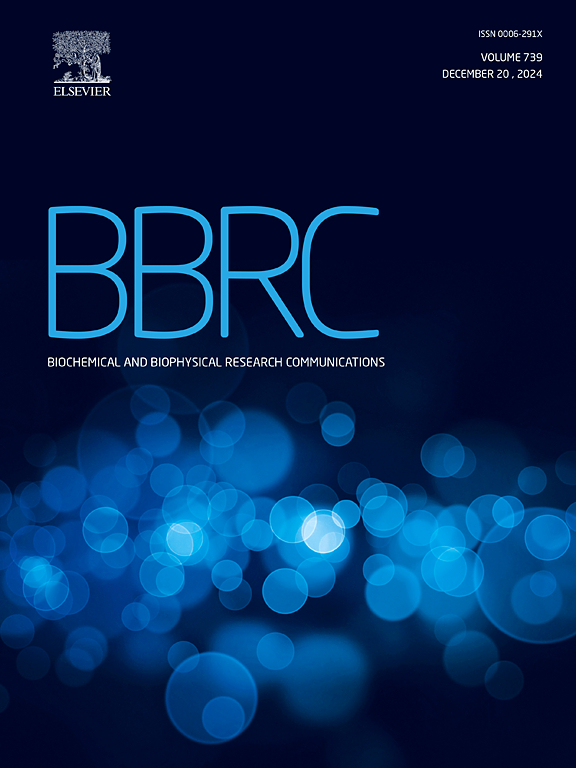Pinocembrin 可通过 NLRP3/DCC 信号通路缓解 LPS 诱导的小鼠抑郁样行为。
IF 2.5
3区 生物学
Q3 BIOCHEMISTRY & MOLECULAR BIOLOGY
Biochemical and biophysical research communications
Pub Date : 2024-10-23
DOI:10.1016/j.bbrc.2024.150870
引用次数: 0
摘要
目的:抑郁症是一种普遍存在的严重精神障碍,其发病机制和治疗方法一直是研究的重要领域。传统的抗抑郁药物往往受限于延迟治疗效果和显著的不良反应,因此有必要开发创新而有效的治疗模式。多种证据表明,外周和中枢炎症在抑郁症中起作用,而抗炎药物可以改善炎症相关抑郁症患者的抑郁症状。Pinocembrin (PB)是一种天然生物活性化合物,以其抗炎和抗氧化特性而闻名,但其作用和机制尚不清楚。方法:(1)急性炎症模型采用脂多糖(LPS)诱导小鼠抑郁样行为,腹腔注射 LPS,剂量为 0.83 mg/kg。评估了 PB(20 毫克/千克,静注)和 NLRP3 炎症体抑制剂 MCC950(10 毫克/千克,静注)对改善小鼠抑郁行为的作用。(2)探讨PB通过调节NLRP3和Netrin-1/DCC通路改善LPS小鼠抑郁样行为的具体机制:结果表明:腹腔注射 LPS 后,小鼠体重、蔗糖偏好评分显著下降,尾悬空不动时间显著增加。PB和MCC950能提高小鼠的蔗糖偏好评分,减少尾悬液不动时间。此外,PB和MCC950还能抑制NLRP3相关神经炎症的表达,下调Netrin-1/DCC信号通路,改善小鼠海马神经可塑性:总之,PB通过减少海马NLRP3炎症体的表达和下调Netrin-1/DCC信号通路,明显改善了LPS诱导的小鼠抑郁样行为。此外,研究还发现 PB 能调节α-氨基-3-羟基-5-甲基-4-异恶唑受体(AMPAR)和突触后密度 95(PSD95),保护兴奋性突触传递并增强突触可塑性。这项研究表明,PB 能有效改善 LPS 诱导的抑郁症状,为抑郁症的临床治疗提供了一种新策略。本文章由计算机程序翻译,如有差异,请以英文原文为准。
Pinocembrin alleviates LPS-induced depressive-like behavior in mice via the NLRP3/DCC signaling pathway
Objective
Depression, a prevalent and severe mental disorder, continues to be a significant area of research concerning its pathogenesis and therapeutic approaches. Conventional antidepressants are often limited by delayed therapeutic effects and notable adverse reactions, necessitating the development of innovative and efficacious treatment modalities. Multiple lines of evidence suggest that peripheral and central inflammation play a role in depression, and that anti-inflammatory drugs can ameliorate depressive symptoms in patients with inflammation-related depression. Pinocembrin (PB), a natural bioactive compound, is renowned for its anti-inflammatory and antioxidant properties, while the effect and mechanism of PB are still unclear. Consequently, this study employs PB as an intervention to investigate its effects on depression in mice model, with the objective of establishing a novel therapeutic strategy and foundational data for the treatment of depression.
Methods
(1) The acute inflammation model used lipopolysaccharide (LPS) to induce depression-like behavior in mice by injecting LPS intraperitoneally at a dose of 0.83 mg/kg. The effects of PB (20 mg/kg, i.p.) and the NLRP3 inflammasome inhibitor MCC950 (10 mg/kg, i.p.) on improving depression behavior in mice were evaluated. (2) To explore the specific mechanism of PB in improving depression-like behavior in LPS mice by regulating NLRP3 and Netrin-1/DCC pathway.
Results
The results showed that after intraperitoneal injection of LPS, the mice exhibited a significant decrease in body weight, sucrose preference score, and a significant increase in tail suspension immobility time. Treatment with PB and MCC950 increased the sucrose preference score and decreased the tail suspension immobility time. Besides, PB and MCC950 could inhibit the expression of NLRP3 related neuroinflammation, down-regulated the Netrin-1/DCC signaling pathway, and improved hippocampal neuroplasticity in mice.
Conclusion
In conclusion, PB significantly improved LPS-induced depression-like behavior in mice by reducing the expression of hippocampal NLRP3 inflammasome and down-regulating the Netrin-1/DCC signaling pathway. Additionally, PB was found to regulate α-amino-3-hydroxy-5-methyl-4 isoxazole receptor (AMPAR) and postsynaptic density 95 (PSD95), protecting excitatory synaptic transmission and enhancing synaptic plasticity. This study demonstrates the effectiveness of PB in improving depressive symptoms induced by LPS and provides a new strategy for the clinical treatment of depression.
求助全文
通过发布文献求助,成功后即可免费获取论文全文。
去求助
来源期刊
CiteScore
6.10
自引率
0.00%
发文量
1400
审稿时长
14 days
期刊介绍:
Biochemical and Biophysical Research Communications is the premier international journal devoted to the very rapid dissemination of timely and significant experimental results in diverse fields of biological research. The development of the "Breakthroughs and Views" section brings the minireview format to the journal, and issues often contain collections of special interest manuscripts. BBRC is published weekly (52 issues/year).Research Areas now include: Biochemistry; biophysics; cell biology; developmental biology; immunology
; molecular biology; neurobiology; plant biology and proteomics

 求助内容:
求助内容: 应助结果提醒方式:
应助结果提醒方式:


